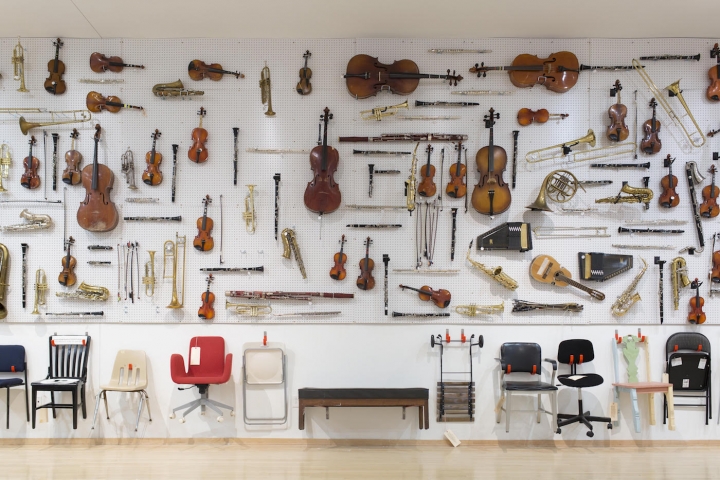A Symphony Scored from a School District’s 1,000 Broken Instruments
The School District of Philadelphia has over 1,000 broken musical instruments, from flutes with bent keys to trombones missing slides. Some of their fixes are easy, others complex, yet due to funding cuts in the city, the district doesn’t have a budget for either. Each broken instrument represents a student who’s unable to participate in music programs. When Robert Blackson, director of exhibitions and public programs at Temple University’s Tyler School of Art, learned about the issue, he saw an opportunity to draw attention to the struggle of music education, while also raising money for repairs.
“I had the privilege of going in one of those schools that were closed [due to the budget deficit], and went into a room of pianos that were broken,” Blackson told Hyperallergic. The sight stayed in his mind, and he discovered that there were numerous damaged instruments sitting silent in the storerooms of Philadelphia’s public schools. “That started the snowball effect of, holy moly, there are over 1,000 of them! We could take what’s been seen as mostly a problem and make it a creative opportunity, and a point where we can start to fix them.”

That opportunity became the Symphony for a Broken Orchestra, a partnership between Temple Contemporary, the School District of Philadelphia, the Philadelphia Orchestra, the Boyer College of Music & Dance, and other local organizations. The two-year initiative, supported by the Pew Center for Arts and Heritage, has several stages, the first of which took place earlier this year at Temple Contemporary, where the instruments were installed as an exhibition. “Putting them all up on the wall, we began to really see the problem,” Blackson said.
After that, each cracked cello and neckless violin was brought down and played; whatever noise it could make was recorded through David Lang’s Found Sound Nation. Lang often works with unconventional music, as in his one-man opera The Loser, staged on a column above the BAM opera house, or the recent Anatomy Theater, based on 18th-century dissections. For the Symphony for a Broken Orchestra, he will create an orchestration from the cacophony of the Philadelphia schools’ imperfect instruments. Blackson explained that it was “actually quite easy” to get the Pulitzer Prize–winning composer involved — he responded enthusiastically to Blackson’s first email in under five minutes. “He came through the public school, and he really anchors his practice to an early awareness from those days,” Blackson said.


Lang’s symphony will premiere later this year with hundreds of volunteer musicians, including local professionals, amateurs, and students. “You’ll have someone who spends their entire life playing violin, and then they’re being asked to play a violin without strings, and then they’re sitting next to a 10th grader with the same instrument,” Blackson said. “It’s a beautiful leveler.” Following the performances, the instruments will be repaired and returned to schools by the fall of 2018.
Currently, members of the public can “adopt” an instrument to support current and future maintenance through the Symphony for a Broken Orchestra website, clicking on available instruments to hear their sounds. A euphonium with stuck valves wails beautifully in a minor key, while a tenor saxophone lacking a mouthpiece and neck rattles with clattering joints. A few of the instruments are so old as to be antiques, such as a dented Empire French horn with a lost valve that still sounds out gorgeous tones and a snare drum from the 1970s or ’80s with a busted head and a low hum. Those instruments that cannot be repaired for play, like a violin with a smashed face, may be used as teaching devices to show students how they’re built.
“We have enough money now to fix all these broken instruments, but we know that they will get dropped down the stairs or what have you,” Blackson said. To that end, instrument repair kits will be installed in schools as part of the project, in order to build a sustainable system. “If it’s the right fix, it can be done quickly, and put the instrument into the kids’ hands.”




